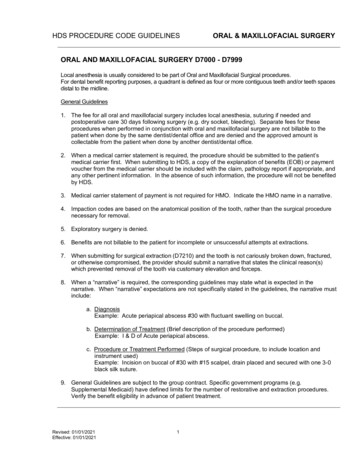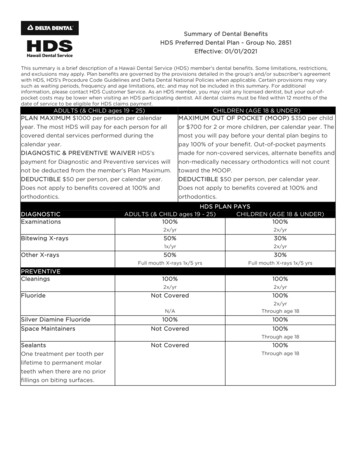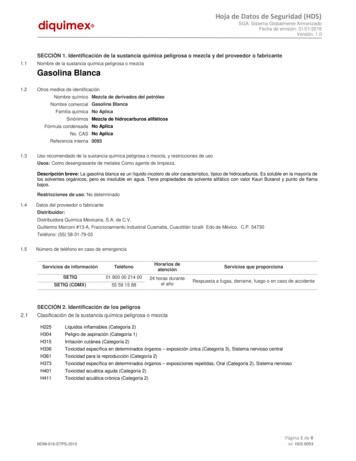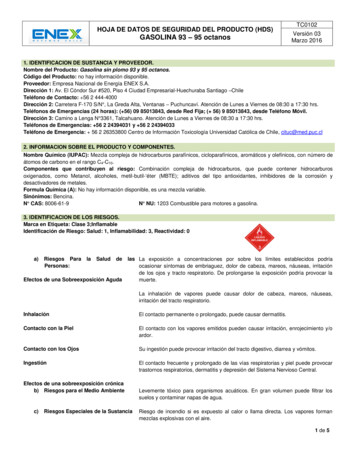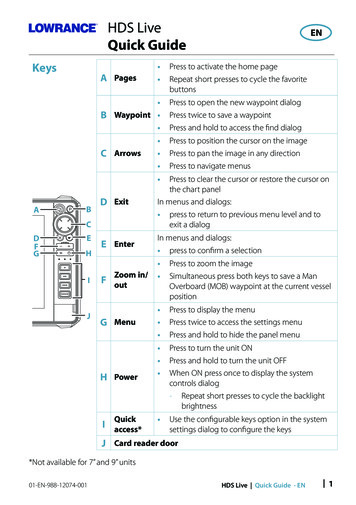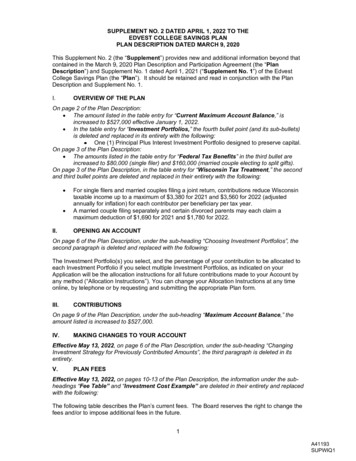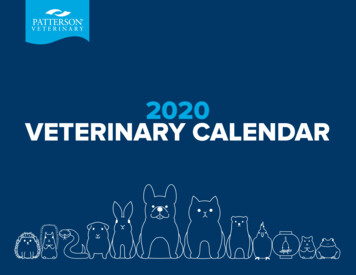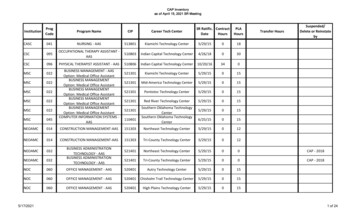
Transcription
TechnicalSupplementForm 5HDSHO GAN D E V E LO P ME NT S U RVE YT H ES C I E N C EO FP E R S O N A L I T Y
TechnicalSupplementForm 5 2014 by Hogan Press, a division of Hogan Assessment Systems, Inc.Published in the United States of America.For information, contact Hogan Press, 2622 E. 21st St., Tulsa, OK 74114.www.hoganassessments.comISBN 978-0-9889286-7-1
Technical SupplementTable of ContentsIntroduction .5Development of HDS Subscale Structure .5Composition of the HDS Scales: Factor Analyses .8Procrustes Analysis .9HDS Scale and Subscale Distributions and Reliability .11HDS Parallel Forms Reliability .13Construct Validity of the New HDS Form .15Correlations with Other Assessments .15Samples and Instruments .15Results of Scale-to-Scale Correlates .21Correlations with Others’ Descriptions .25Samples and Instruments .25Results of Scale and Observer Description Correlates .29Interpretation of HDS Scale and Subscale Scores .31Sample HDS Profile Interpretations .33Utility of HDS Subscale Information .41Accuracy of HDS Scales .41Value of Subscale Information .43Alignment between New HDS Form and Existing Interpretive Text .45Expert Testimonials .46References .473
Technical SupplementTables and FiguresTable 1Subscale Names, Definitions, and Sample Items .6Table 2Varimax Rotated Factor Matrix for HDS Subscales .8Table 3Procrustes Analysis of New HDS to HDS Currently in Use .10Table 4Classical Scale and Subscale Statistics for the HDS .12Table 5HDS Test-Retest and Parallel Forms Reliability .13Table 6Correlations Between HDS Scales and HPI Scales .17Table 7Correlations Between HDS Scales and CPI Scales .17Table 8Correlations Between HDS Scales and NEO PI-R Scales/Facets .18Table 9Correlations Between HDS Scales and IPIP Big 5 20-Item Scales .19Table 10Correlations Between HDS Scales and 16PF Scales .19Table 11Correlations Between HDS Scales and MVPI Scales .19Table 12Correlations Between HDS Scales and CISS Interest and Skill Scales .20Table 13Correlations Between HDS Scales and JPI-R Scales .20Table 14HDS Correlations with Observer Ratings for Big-Five Mini-Marker Adjectives .26Table 15HDS Correlations with Observer Ratings for Big-Five Inventory Phrases .27Table 16Sample Interpretations for High HDS Scores with and without Subscales .32Figure 1HDS “Moving Away” Profile .33Figure 2HDS “Moving Against” Profile .34Figure 3HDS “Moving Toward” Profile .35Figure 4HDS “Corporate Guerilla” Profile .36Figure 5HDS “Insecure Showboat” Profile .37Figure 6HDS “Litigious” Profile .38Figure 7HDS “Fear-Driven Salesman” Profile .39Figure 8Accuracy of HDS Scale Scores in New Form vs. Existing HDS .42Figure 9Dichotomous Accuracy of HDS Scale Scores in New Form vs. Existing HDS .42Figure 10Added Value of HDS Subscale Scores in New Form .43Figure 11Dichotomous Added Value of HDS Subscale Scores in New Form .44Figure 12Alignment Between New HDS Scale Scores and Existing HDS Reports .45Figure 13Dichotomous Alignment Between New HDS Scale Scores and Existing HDS Reports .454
Technical SupplementIntroductionSince its introduction, the HDS has been used by organizations across the globe to identify and mitigatepersonality derailers through applicant screening or employee development. The 11 primary scales of theHDS fill a niche in personality assessment by providing valid information that can be used by organizationsand individual employees about derailing personality characteristics. Because each HDS scale manifestsitself through different behaviors, cataloging these behavioral themes provides a finer-grained description ofeach person’s derailers. For example, two individuals with high Excitable scale scores may behave differentlywhen under stress. One may become emotionally volatile and moody, whereas the other may give up onpeople or projects. Thus, when interpreting HDS results it is useful to explore deeper levels of how eachderailer manifests itself. This technical supplement details the development of a subscale structure for theHDS, presents new psychometric evidence, provides an overview of scale and subscale interpretation, anddescribes testimonials from experts using HDS subscales in applied contexts.Development of HDS Subscale StructureTwo separate lines of inquiry led to the development of a subscale structure for the HDS. First, years ofinterpreting HDS results led to the recognition of predictable behavioral themes associated with each ofthe 11 primary scales. Second, clients began asking for more detailed information for each HDS scale.These observations signaled a need to review each HDS scale to identify subscales represented bybehavioral themes. To address this need, the Hogan Research Division created a task force led by foursenior psychologists with Ph.D.s and an average of 24 years of professional experience. They reviewed thecontent of the scales and identified three behavioral subscale themes for each of the 11 primary scales.Although most HDS items fit well with this new subscale structure, we piloted over 250 candidate itemsto better define the new HDS subscale structure. In 18 separate research studies, an average of 2,435individuals completed the HDS and sets of experimental items as part of personnel selection, employeecoaching, leadership development, and other applications. This helped ensure adequate representationof occupational (i.e., job family, job level, tenure) and demographic (i.e., age, sex, race/ethnicity)variables of interest. After each round of testing, we analyzed the psychometric properties of HDS items,subscales, and scales (i.e., descriptive statistics, differences across applications of HDS data, item-scalecorrelations, subscale and scale reliability) and retained items for further testing that correlated withexisting HDS scales.Following pilot testing, we worked with Dr. Lew Goldberg from the Oregon Research Institute (ORI) toobtain reliability and validity evidence for the HDS subscale structure. Specifically, we obtained data forthe HDS subscale structure through the longitudinal Eugene-Springfield Community Sample (ESCS). Thissample contains over 1,000 individuals recruited by Dr. Goldberg to participate in longitudinal research,completing over 30 different psychological instruments over several years. One hundred sixty-two ofthese participants provided HDS subscale data, allowing us to determine the viability of this structurethrough descriptive statistics, reliability evidence, and convergent and discriminant construct validityvia correlations with other instruments completed by ESCS participants. Information obtained from thistesting supported the reliability and validity of the new HDS subscale structure. We provide this evidencein subsequent sections of this technical supplement.5
Technical SupplementThese results supported the psychometric properties of the new HDS subscale structure, but conveyedno meaningful information about how individuals behave in stressful situations. To investigate how wellthe HDS subscale structure describes individual behavior, we collected HDS scale and subscale data fromover 2,200 individuals. Many of these individuals completed the HDS for Hogan certification workshops,which include feedback sessions with a certified Hogan coach. We provided HDS scale and subscaledata to Hogan coaches prior to these feedback sessions, and surveyed coaches following each sessionto gauge their impressions of the HDS subscale structure. We asked coaches whether the HDS subscalestructure added value to their interpretation of HDS scale results, whether the subscales were moreor less accurate than existing HDS scales in describing individuals, and how well subscale informationaligned with existing interpretive information for HDS scales. Survey results from Hogan coaches indicatedthat the subscale structure accurately described individual behavior and added significant value tointerpretation of HDS results.Implementation of the HDS subscale structure began with translation of content to support global use ofthe new structure. Each 14-item HDS scale is represented by three subscales; two five-item subscalesand one four-item subscale. The HDS subscales, their definitions, and sample items appear in Table 1.Table 1. Subscale Names, Definitions, and Sample ItemsHDS SubscaleDefinitionSample ItemExcitable: VolatileMoody, often angered or annoyed, easily upset andhard to soothe.I can get angry quickly.Excitable: EasilyDisappointedInitial passion for people and projects, who inevitablydisappoint, and passion then turns to rejection.Few people have met my expectations.Excitable: No DirectionLacking few well defined beliefs or interests, but withregrets about past behavior.Sometimes I am not sure what I really believe.Skeptical: CynicalProne to doubt others’ intentions and assume theyhave bad ulterior motives.When someone does me a favor, I wonderwhat he/she wants.Skeptical: MistrustingGeneralized mistrust of people and institutions; beingalert for signs of perceived mistreatment.People who are in charge will take advantageof you if you let them.Skeptical: GrudgesHolding grudges and being unwilling to forgive real orperceived wrongs.There are some people I will never forgive.Cautious: AvoidantAvoiding new people and situations to avoid imaginedpotential embarrassment.I feel awkward around strangers.Cautious: FearfulAfraid of being criticized for making mistakes and beingreluctant to act independently or make decisions.People sometimes think I am timid.Cautious: UnassertiveUnwilling to act assertively and therefore prone tobeing overlooked or ignored.People tell me I’m not assertive enough.Reserved: IntrovertedValuing one’s private time and preferring to work alone.I consider myself a loner.Reserved: UnsocialKeeping others at a distance, limiting closerelationships, and being generally detached.I prefer to keep people at a distance.Reserved: ToughIndifferent to the feelings and problems of others,focused on tasks rather than people.Other people’s problems don’t concern me.Leisurely: PassiveAggressiveOvertly pleasant and compliant but privately resentfuland subversive regarding requests for improvedperformance.I sometimes put off doing things for people Idon’t like.Leisurely:UnappreciatedBelieving that one’s talents and contributions areignored; perceiving inequities in assigned workloads.People at work expect me to do everything.Leisurely: IrritatedPrivately but easily irritated by interruptions, requests,or work related suggestions.It irritates me to be interrupted when I amworking on something.6
Technical SupplementTable 1. Subscale Names, Definitions, and Sample Items (Continued)HDS SubscaleDefinitionSample ItemBold: EntitledFeeling that one has special gifts andaccomplishments and, consequently, deserves specialtreatment.I would never take a job that is beneath me.Bold: OverconfidenceUnusually confident in one’s abilities; belief that onewill succeed at anything one chooses to undertake.I do many things better than almost everyoneI know.Bold: Fantasized TalentBelieving that one has unusual talents and gifts andthat one has been born for greatness.I was born to do great things.Mischievous: RiskyProne to taking risks and testing limits; deliberatelybending or breaking inconvenient rules.I try things that other people think are toorisky.Mischievous: ImpulsiveTending to act impulsively without considering the longterm consequences of one’s actions.I often do things on the spur of the moment.Mischievous:ManipulativeMachiavellian tendencies--using charm to manipulateothers and no remorse about doing so.When I want to get my way, I know how to“turn on the charm.”Colorful: PublicConfidenceExpecting others to find one’s public performancesfascinating and not knowing when to be quiet.In a group, I am often the center of attention.Colorful: DistractibleEasily distracted, minimal focus, needing constantstimulation, confusing activity with productivity.I like to have several things going on at thesame time.Colorful: Self-DisplayWanting to be the center of attention and usingdramatic costumes and gestures to attract attention tooneself.I sometimes dress so as to stand out fromthe crowd.Imaginative: EccentricExpressing unusual views that can be either creativeor merely strange; tendency to be absorbed in theseideas.People describe me as unconventional.Imaginative: SpecialSensitivityBelieving that one has special abilities to see thingsothers don’t and understand things others can’t.I sometimes feel I have special talents andabilities.Imaginative: CreativeThinkingBelieving that one is unusually creative; easily boredand confident in one’s imaginative problem solvingability.Many of my ideas are ahead of their time.Diligent: StandardsHaving exceptionally high standards of performance foroneself and others.I have high standards for my performance atwork.Diligent: PerfectionisticPerfectionistic about the quality of work products andobsessed with the details of their completion.I tend to be a perfectionist about my work.Diligent: OrganizedMeticulous and inflexible about schedules, timing, andrules and procedures.I am fussy about schedules and timing.Dutiful: IndecisiveOverly reliant on others for advice and reluctant tomake decisions or act independently.On important issues, I dislike makingdecisions on my own.Dutiful: IngratiatingExcessively eager to please one’s superiors, tellingthem what they want to hear, and never contradictingthem.There is nothing wrong with flattering yourboss.Dutiful: ConformingTaking pride in supporting one’s superiors andfollowing their orders regardless of one’s personalopinion.I take pride in being a good follower.7
Technical SupplementComposition of the HDS Scales: Factor AnalysesFactor analysis is a statistical methodology designed to account for the relationships between manyvariables using a smaller number of “factors.” A factor represents something shared in common bydifferent variables; it is a linear combination of items which together define a single construct. Thus, thistechnique allows us to examine whether responses to different HDS items cluster together into meaningfulfactors, and to make sense of the many thousands of relationships between individual assessment items.To test the factor structure of the HDS, we used a sample of 2,524 employed adults and conducted anexploratory Principal Components Analysis (PCA) to determine the underlying constructs (or “principalcomponents”) of the HDS. We chose the number of components to extract based on the size of theEigenvalues and an examination of several alternate solutions. Finally, we refined the components usingorthogonal Varimax rotation to find the most economical solution with the goal of associating each HDSsubscale to one factor. To address methodological differences, we also conducted Principal Axis Factoring(PAF) on these same data and found the same results in terms of primary and secondary factor loadingsas previously found through PCA analyses. Table 2 presents the results of our PCA factor analysis.Table 2. Varimax Rotated Factor Matrix for HDS SubscalesScales & SubscalesExcitable: VolatileExcitable: Easily DisappointedExcitable: No DirectionSkeptical: CynicalSkeptical: MistrustingSkeptical: GrudgesCautious: AvoidantCautious: FearfulCautious: UnassertiveReserved: IntrovertedReserved: UnsocialReserved: ToughLeisurely: Passive AggressiveLeisurely: UnappreciatedLeisurely: IrritatedBold: EntitledBold: OverconfidenceBold: Fantasized TalentMischievous: RiskyMischievous: ImpulsiveMischievous: ManipulativeColorful: Public ConfidenceColorful: DistractibleColorful: Self-DisplayImaginative: EccentricImaginative: Special SensitivityImaginative: Creative ThinkingDiligent: StandardsDiligent: PerfectionisticDiligent: OrganizedDutiful: IndecisiveDutiful: IngratiatingDutiful: 37.68.54.54.56.41-.38.71.68.67.69.67.548
Technical SupplementThese data provided initial support for the subscale structure of the HDS. Five subscales loaded on morethan one factor, possibly due to the factors being constrained to be independent from one another via theVarimax rotation.The subscales with the highest loadings on factor I are Easily Disappointed, Unsocial, Mistrusting,Irritated, and Cynical. The factor is also defined by significant loadings for the Introverted, Volatile, NoDirection, Grudges, and Avoidant subscales. Moderate loadings on this factor are also seen for theTough, Unappreciated, and Fear ful subscales; Unassertive and Passive Aggressive subscales alsoload on factor I, with cross-loadings on factor III. Overall, this factor describes a syndrome of emotionalvolatility, mistrust, excess caution, and aloof and passive aggressive behavior. Together, these loadingssupport the underlying factor described by Horney (1950) as “moving away from people” and managinginsecurities by avoiding connections with others.The subscales with the highest loadings on factor II are Impulsive, Self-Display, Public Confidence,Fantasized Talent, and Manipulative. This factor is also defined by substantial loadings for the CreativeThinking, Risky, Eccentric, and Special Sensitivity subscales. Entitled, Overconfidence, and Distractiblesubscales also load moderately on factor II, with cross-loadings for Overconfidence and Distractible onfactor IV. Overall, this factor describes a dysfunctional disposition of arrogance, manipulation, attentionseeking, and odd and eccentric behavior. Together, these loadings support the underlying factor describedby Horney (1950) as “moving against people” by dominating, manipulating, and intimidating others as ameans of managing self-doubt.For factor III, the Indecisive and Ingratiating subscales show the highest loadings, with a significant loadingalso noted for the Conforming subscale. The Unassertive, Fearful, and Passive Aggressive subscales fromfactor I also show cross-loadings on this factor. Overall, this factor describes a dysfunctional dispositionof dependent and submissive behavior. These loadings support part of the underlying factor described byHorney (1950) as “moving toward people” by managing insecurities by building alliances.The subscales with the highest loadings on factor IV are Standards, Perfectionistic, and Organized.The Overconfidence and Distractible subscales from factor II cross-load on this factor, with a negativecross-loading on factor IV for Distractible. Overall, this factor describes a dysfunctional disposition ofmeticulousness, perfectionism, and orderly and hyper-focused behavior. These loadings also support theunderlying “moving toward people” factor, or managing insecurities by minimizing the threat of criticism.Procrustes AnalysisA different approach to factor analysis often used in cross-cultural psychology is Procrustes rotation(Schönemann, 1966). With this analysis, factor loadings for one assessment are compared against thefactor loadings for another assessment, and congruence coefficients are computed to determine the degreeof similarity between the two assessments. Using an accepted rule of thumb, we can evaluate congruencecoefficients to determine whether the two assessments are functionally equivalent. Although some (McCrae,Zonderman, Costa, & Bond, 1996; Mulaik, 1970) have argued that a coefficient of .90 is required foracceptable congruence, others (Chan, Leung, Chan & Yung, 1999; Lorenzo-Seva & ten Berge, 2006) haveindicated that coefficients as low as .85 are indicative of “fair similarity.” From this, we can extrapolate thatcongruence coefficients between .85 and .89 are acceptable, with values at or above .90 preferred.9
Technical SupplementTo verify the functional equivalence of the new form of the HDS against the HDS currently in use, weconducted Procrustes analyses using 2,524 cases of data for the new HDS form, comparing the currentand new forms of the HDS to the HDS normative dataset. All data were collected from working adults.Using scale-level HDS data, the first step in performing these analyses was to conduct a maximumlikelihood extraction of four factors consistent with that performed on the original HDS data. We thenrotated the factor loadings for the new HDS form to the matrix for the HDS currently in use. Theseanalyses yielded congruence coefficients for each scale, each factor, and the overall assessmentas seen in Table 3. The overall congruence coefficient was .95, indicating that the new form of theHDS demonstrates good structural equivalence with the current form of the HDS. To provide a richerinterpretation of the results, we also looked to the factor and scale congruence coefficients. Congruencecoefficients for the four factors were .97, .98, .93, and .75 for Moving Away, Moving Against, Diligent, andDutiful factors, respectively. Because all but one of these coefficients is above the .90 threshold, we canconclude that the bulk of the factor structure of the new HDS form is congruent with that of the currentform of the HDS.Of the 11 HDS scales, 10 had congruence coefficients of .90 or greater, indicating that the new form ofthe HDS demonstrates structural equivalence with the current HDS at the scale level. The congruencecoefficient for one scale (Dutiful) fell below our .90 threshold, but at .82, it can still be consideredindicative of fair similarity (Lorenzo-Seva & ten Berge, 2006). Overall, our findings suggest that the newform of the HDS is structurally congruent with the current HDS, with results consistent with those foundwhen comparing the original English HDS against translated forms of the assessment.Table 3. Procrustes Analysis of New HDS to HDS Currently in UseCongruence CoefficientVariableOverallMoving ing AgainstBoldMischievousColorfulImaginativeDiligent FactorDiligentDutiful FactorDutifulCurrent HDS 97.98.87New HDS 8210
Technical SupplementHDS Scale and SUBSCALE Distributions and ReliabilityTable 4 presents the number of items in each HDS subscale and scale, descriptive statistics (i.e., means,standard deviations, skewness, kurtosis), internal consistency reliability, average inter-item correlations,and standard errors of measurement.Skewness refers to departure from symmetry in a score distribution. When a distribution is normal andsymmetrical, skewness values are around zero. Positive skewness values indicate that most scores bunchat the bottom end of a distribution, and negative skewness values indicate that most scores bunch onthe top end of a distribution. Skewness values greater than 1.0 or less than -1.0 generally indicate asignificant departure from symmetry.Kurtosis refers to how peaked or flat a score distribution is relative to the normal distribution. Whenscores are normally distributed, kurtosis values will be around zero. When the distribution is sharperthan the normal distribution, kurtosis values will be positive. When the distribution is broader than thenormal distribution, kurtosis values will be negative. Kurtosis values of more than twice the standard errorindicate a significant departure from the normal distribution.Internal consistency reliability is an estimate of how well all the items of a subscale or scale estimatea common attribute. If all the items of a subscale or scale measure the same construct, internalconsistency reliability will be high. However, if the items of a subscale or scale measure different things,internal consistency will be lower.As a second way of examining internal consistency, we also reviewed correlations between items for eachsubscale and scale (DeVellis, 1991). If a group of items measures a single attribute, items in the scaleshould be positively correlated. Average inter-item correlations provide information about how stronglyitems in the subscale or scale hang together. Clark and Watson (1995) suggest that average inter-itemcorrelations be at least .15, although other rules of thumb advocate lower levels depending on theheterogeneity of the construct.We also provide two estimates for the standard error of measurement for each HDS scale and subscale. Ifone person were to complete the HDS repeatedly, the standard deviation of his/her repeated test scoresis denoted as the standard error of measurement. We compute the standard error of measurement basedon both observed scores and true score estimates (Dudek, 1979).To examine the distributions and reliabilities for HDS subscales and scales, we administered the new formof the HDS to 2,718 Hogan participants. This sample included business development groups, universityclassroom participants, and public and private workshops with working adults. On average, participantswere 25.53 years of age (SD 11.51), and the sample included 1,235 males and 1,048 females (435did not indicate their sex). Based on the data from this sample, we computed descriptive statistics,reliability estimates, and standard errors that appear in Table 4.11
Technical SupplementTable 4. Classical Scale and Subscale Statistics for the HDSScaleSubscaleExcitableVolatileEasily DisappointedNo cialToughLeisurelyPassive nfidenceFantasized lPublic tricSpecial SensitivityCreative 79-0.65-1.10-0.19-0.68-0.
HDS fill a niche in personality assessment by providing valid information that can be used by organizations and individual employees about derailing personality characteristics. Because each HDS scale manifests itself through different behaviors, cataloging these behavioral themes provides a finer-grained description of each person's derailers.
